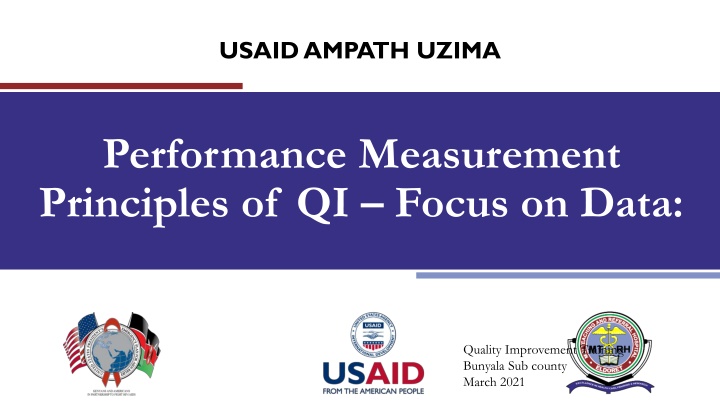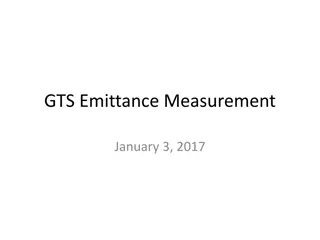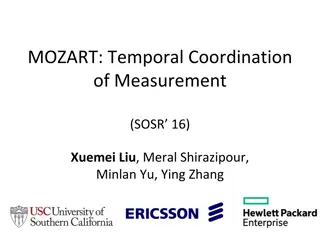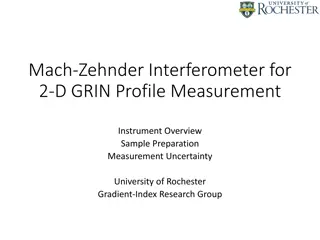
Principles of Quality Improvement in Healthcare Training
Explore the USAID.AMPATH.UZIMA performance measurement training focusing on principles of Quality Improvement (QI) in healthcare. Learn about data-driven decision-making, measurement methods, indicators, and the importance of quality care. Discover the balance between performance measurement and QI activities while understanding sources of data for measuring quality.
Download Presentation

Please find below an Image/Link to download the presentation.
The content on the website is provided AS IS for your information and personal use only. It may not be sold, licensed, or shared on other websites without obtaining consent from the author. If you encounter any issues during the download, it is possible that the publisher has removed the file from their server.
You are allowed to download the files provided on this website for personal or commercial use, subject to the condition that they are used lawfully. All files are the property of their respective owners.
The content on the website is provided AS IS for your information and personal use only. It may not be sold, licensed, or shared on other websites without obtaining consent from the author.
E N D
Presentation Transcript
USAID AMPATH UZIMA Performance Measurement Principles of QI Focus on Data: Quality Improvement Training Bunyala Sub county March 2021
LEARNING OBJECTIVES By the end of this session, participants will be able to: Link measurement and Aim statements and drivers Compare and contrast process, outcome and balancing indicators Explain the importance of measuring quality of care and usefulness of data Explain the methods to measuring quality Define indicators and mention their characteristics USAID AMPATH Uzima
Principles of QI Systems approach to management Process orientation Total Quality Management Leadership Customer Orientation and Stakeholder involvement Continuous Quality Improvement This session will focus on methods to make evidence based decisions as one of the core principles of QI. Evidence Based Decision Making Measurement of data allows us to quantify the current level of compliance with expected standards and guidelines of care as well as client needs and expectations... and monitor whether quality improvement resulted from the change intervention USAID AMPATH Uzima
What IS and SHOULD be the situation at the facility USAID AMPATH Uzima
Performance measurement is a culture shift To We are committed to tracking measures that matter most. We are accountable for delivering our outputs and our intermediate outcomes. We are responsible for our end outcomes. From These measures are draining valuable resources and are a data burden I can t measure my outcomes I can only measure activities I need these measures because my employees feel it is important You can t measure my program. USAID AMPATH Uzima
Balance between Performance Measurement and Quality Improvement Activities Quality Management Program USAID AMPATH Uzima
SOURCES OF DATA FOR MEASURING QUALITY Various tools can be used to measure structures, processes and outcomes. Sources of data are shown on the next slide. USAID AMPATH Uzima
Reference: KHQIF Chapter 3- Performance Measurement, Table 3.2 Activity (grouped) Source Method of collection Review Period Level of Data Use Facility QI Organizational Assessment Facility staff Interview/FGD using OA checklist Annually Facility, County and National County/ National QI Organizational Assessment County/ National Staff Interview/FGD using OA checklist Annually County, National Staff feedback Facility staff Staff meetings, Monthly Facility Staff survey (anonymous) Annually Facility Client/ consumer/ community feedback Clients Focus group discussions during clinic visits Ongoing Facility Community Community Meetings Varies Facility Clients Support group discussions Ongoing Facility Clients Exit interviews Every 6 months Facility Clients/ community Suggestion boxes Ongoing Facility Routine reports/ HIS data, including routine cohort analysis (ART, HEI/HCA, EWI) Registers, reports-DHIS Daily/routine facility documentation of services Varies daily, monthly, quarterly, annually Facility, County, and National File Reviews Patient files, EMR database Chart abstraction for predefined sample (95%CI) or All eligible clients for facilities with EMR systems 6 Monthly Facility, County, National USAID AMPATH Uzima
Data/types for identifying, prioritizing, and measuring change in QI projects Quality Dimensions Safety Adverse events and incidents (Side effects and Toxicity) Sentinel Events ( Early Warning Indicators) Benchmarking against other services/departments Accessibility Service utilization Client Feedback (e.g. client focus groups, exit surveys) Waiting times Effectiveness Clinical indicators, medical file reviews Morbidity and mortality meetings/reports Efficiency Finance/Expenditure data Audits of equipment/resource usage Waiting times Acceptability/ patient- centeredness Service utilization data Client Feedback Equity Clinical indicators, medical file reviews Service utilization data and service mapping USAID AMPATH Uzima
DEFINITION OF INDICATORS Indicators are quantitative measures used to monitor and evaluate the quality of important governance, management, clinical, and support functions that affect patient outcomes. USAID AMPATH Uzima
INDICATORS Indicators are used to track progress and evaluate change initiatives towards meeting an aim or objective. Answers the question: How will we know if a change leads to an improvement? Primary purpose for measurement in QI is for learning USAID AMPATH Uzima
COMPONENTS OF INDICATORS 1. A numerator The part of a common fraction appearing above the line, representing the number of parts of the whole that are being considered 2. A denominator The number below the line in a simple fraction, which indicates the number of parts making up the whole 3. Time over which the event may take place USAID AMPATH Uzima
CHARACTERISTICS OF INDICATORS S Specific M Measurable A Achievable R Realistic T Time bound USAID AMPATH Uzima
SELECTING APPROPRIATE INDICATORS Skilled QI practitioners are able to: Determine the appropriate balance of indicators Identify a reasonable number of indicators Select the appropriate type of indicators Ensure that indicators are robust USAID AMPATH Uzima
ENSURINGROBUST INDICATORS In addition to being SMART, robust indicators: Are precise Are consistent over time Use realistic time frames Are valid Are reliable USAID AMPATH Uzima
ROBUST INDICATORS ARE PRECISE Use clear, well-defined language and terms Are not open to interpretation Which indicator is more precise? Number of people who seek testing Number of women, ages to 15-49, who reside in the district and present to the clinic for testing in the first two quarters of 2013 USAID AMPATH Uzima
ROBUST INDICATORS ARE CONSISTENT Dropping or modifying indicators during a project weakens the measurement process For example: Consider an indicator such as the percent of women adequately linked to services If the definition of adequately linked changes from linked to 3 of 5 services in year 1 to linked to 5 of 10 services in year 3, performance may appear to weaken, even if women are referred to more services over time USAID AMPATH Uzima
ROBUST INDICATORS USEREALISTIC TIME FRAMES Match the time frame to the intervention Assessing the number of health workers trained to provide PMTCT will take less time than assessing CTX coverage of HIV-exposed infants If a program takes 9 months to launch, measuring outcomes at month 12 may underestimate its impact If an intervention is rolled out to facilities at different times, measuring an indicator in the same month at each site will tell the wrong story USAID AMPATH Uzima
ROBUST INDICATORS ARE VALID Validity is the extent to which an indicator actually measures what it is intended to measure USAID AMPATH Uzima
ROBUST INDICATORSARERELIABLE Reliability is the extent to which an indicator measures the same thing in the same way every time it is used USAID AMPATH Uzima
THE LOGIC MODEL APPROACH INPUTS ACTIVITIES OUTPUTS OUTCOMES IMPACT Products & Services Delivered Work Conducted Resources and Contributions Changes in Individuals, Groups or Communities Input Activity Output Outcome Impact USAID AMPATH Uzima
Types of Indicators IMPACT OUTPUT OUTCOME INPUT PROCESS Reduced perinatal transmission of HIV Providers trained in updated PMTCT service provision Increased use of PMTCT services Human and financial resources Conduct one PMTCT training workshop in each district for providers Development of training materials Indicator: percent of infants HIV+ born to HIV+ women Indicator: # of trainings conducted Indicator: # of staff working in facility Indicator: # of providers who have completed clinical training Indicator: percent of HIV+ women receiving a complete course of ARV prophylaxis Indicator: % of pregnant women who are HIV tested USAID AMPATH Uzima
Donabedian Model Quality of care can be measured on the basis of the following four aspects based on the Donabedian Model Structure Process (Output)** Outcome USAID AMPATH Uzima
QI APPROACH: INDICATORS Process Indicators Structure indicators Outcome Indicators Balancing Indicators USAID AMPATH Uzima
OUTCOME INDICATORS Outcome indicators examine how a project affects individuals, populations or systems They describe how a program influences health and/or health systems Examples include: Surgical site infection rates Outbreak investigations Percent of HCWs demonstrating competency in IPC skills TB treatment success rates USAID AMPATH Uzima
OUTCOME INDICATORSFOR IMPROVEMENT MEASUREMENT How is the system performing? What is the result? Patient and staff satisfaction with the system USAID AMPATH Uzima
PROCESS INDICATORS Process indicators for traditional public health programming can describe program implementation activities. Examples include: Number of HCW s trained Number of supportive supervision visits Number of functional wash bins Number of sharps boxes available Number of IPC staff trained per nursing shift USAID AMPATH Uzima
PROCESS INDICATORS FOR IMPROVEMENT MEASUREMENT Examine how health care services are provided and how a process is working, answer the question: Are the parts or steps in a system working as planned? Examples include: Percent of hand washing compliance Percent of vital sign measurement compliance Percent of wound care compliance Percent prophylactic antibiotic administration pre-surgery USAID AMPATH Uzima
BALANCING INDICATORS Used to detect potential negative or unintended consequences of a change initiative QI tools can help identify possible negative consequences of change ideas Balancing indicators can help determine if these negative consequences are happening USAID AMPATH Uzima
EXAMPLE: BALANCING INDICATORS QI project designed to increase utilization of services may want to monitor service quality and/or patient satisfaction Balancing indicators: Average clinic wait time Frequency of stock outs Percent of patients correctly initiated on TB treatment Patient satisfaction surveys USAID AMPATH Uzima
EXAMPLE: BALANCING INDICATORS QI Project aim statement: Improve retention rates in TB clinic by 10% Balancing indicators: TB clinic wait time TB drug stock outs HR shortages due to work overload USAID AMPATH Uzima
BALANCING INDICATORS: EXAMPLES QI Project aim statement: Increase injection safety compliance Balancing indicators: Needle stock outs Sharps container overfill and stock outs USAID AMPATH Uzima
GROUP WORK Teams will work together to develop a Family of Indicators with one or two: Structure indicators Outcome indicators Process indicators Balancing indicators USAID AMPATH Uzima
USAID AMPATH UZIMA THANK YOU info@ampathkenya.org | www.ampathkenya.org | @ampathkenya






















